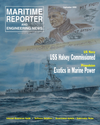
Page 22: of Maritime Reporter Magazine (September 2005)
Marine Propulsion Annual
Read this page in Pdf, Flash or Html5 edition of September 2005 Maritime Reporter Magazine
The acoustical design was again performed by Noise
Control Engineering. The vessel is currently under construction at Dakota Creek Industries in Anacortes,
Wash.
The University wanted an ICES capable ship so that they can conduct "coastal and inland fisheries work where large vessels (like Oscar Dyson) fear to tread…" according to Matt Hawkins, former Cape Henlopen captain and currently the Director of Marine
Operations with the College of Marine Sciences in
Lewes, Delaware. In addition a quieter boat allows the
University to perform more "acoustics work with
Office of Naval Research and Naval Research Labs, two large customers for the UNOLS Fleet."
Like the FRV-40 the R/V Sharp will be a diesel elec- tric plant, use double stage mounted diesels, single stage mounted auxiliaries, extensive damping and insulation. Unlike FRV-40, the Sharp will use a float- ing engine room platform for double stage genset iso- lation and a pair of special vibration isolated Schottel
Z-Drives. With a budget of less than half of that of the
FRV-40, the only way to achieve the CRR-209 is to reduce the speed at which the criterion is achieved.
The R/V Sharp is designed to meet the CRR-209 limit at a speed of eight knots. FRV-40 and most of the other quiet R/V's were operating at 11 knots.
The Future
The expected delivery of Delaware's vessel to its homeport in Lewes is October 2005. The second FRV, now being identified as FSV-2 is expected to be com- pleted in late 2005. It will be home ported at the
NOAA National Marine Fisheries facility in Woods
Hole Massachusetts. A third FSV is under construction at VT Halter Marine and a fourth is planned, but yet to be funded. Matt Hawkins who also serves as the Vice
Chair of UNOLS R/V Operators Committee points out that, "With careful design starting from the initial con- cepts; achieving these underwater radiated noise goals is not unreasonable; even for a vessel not solely dedi- cated to fisheries work. All future R/V's should strive to meet these underwater radiated noise goals because noise impact on the underwater environment is a grow- ing concern and to study the effects of acoustics, and to use acoustic tools for survey, you really need a quiet vessel. The additional cost appears to be mostly up- front, and in very rough terms, it appears to be around 30% more than a conventional vessel not meeting
ICES."
Underwater Noise has been not just the military's problem for at least five years in the U.S. However, the problem is still limited to the Federal government and state organizations. The commercial & private sector has had some involvement with underwater vessel noise, but that is more exception rather than the rule at this time. Commercial technology and ship design are ready and available for low underwater noise vessels and the premiums should only be getting lower as time passes.
About the Author: Michael Bahtiarian is a Vice
President at Noise Control Engineering in Billerica,
Massachusetts. He started his career at General
Dynamics Electric Boat Division as a sound and vibra- tion engineer on the Seawolf (S6W) program. He has a Bachelors degree in mechanical engineering from
Pennsylvania State University and a Master's degree in mechanical engineering from Rensselaer Polytechnic
Institute (RPI). Mr. Bahtiarian is also a Board
Certified acoustical engineer by the Institute of Noise
Control Engineers (INCE). Mr. Bahtiarian and Noise
Control Engineering continue to be involved in both the NOAA FRV-40 and the University of Delaware projects. He can be contacted at mikeb@noise-con- trol.com. 22 Maritime Reporter & Engineering News
Marine Propulsion
Pictures from the launching at Dakota Creek in Anacortes, Wash.
MR SEPTEMBER 2005 #3 (17-24).qxd 9/1/2005 11:27 AM Page 22

 21
21

 23
23
